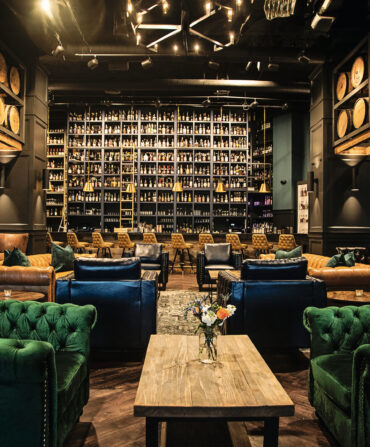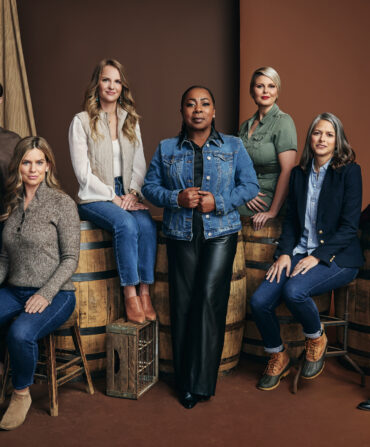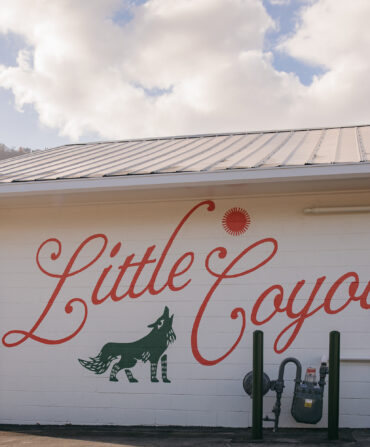Food & Drink
The Mad Scientist of Pawpaws
Largely the domain of foragers, the biggest edible fruit in the South has mostly been forgotten. A quietly obsessed Quaker from West Virginia has made it his life’s mission to change that
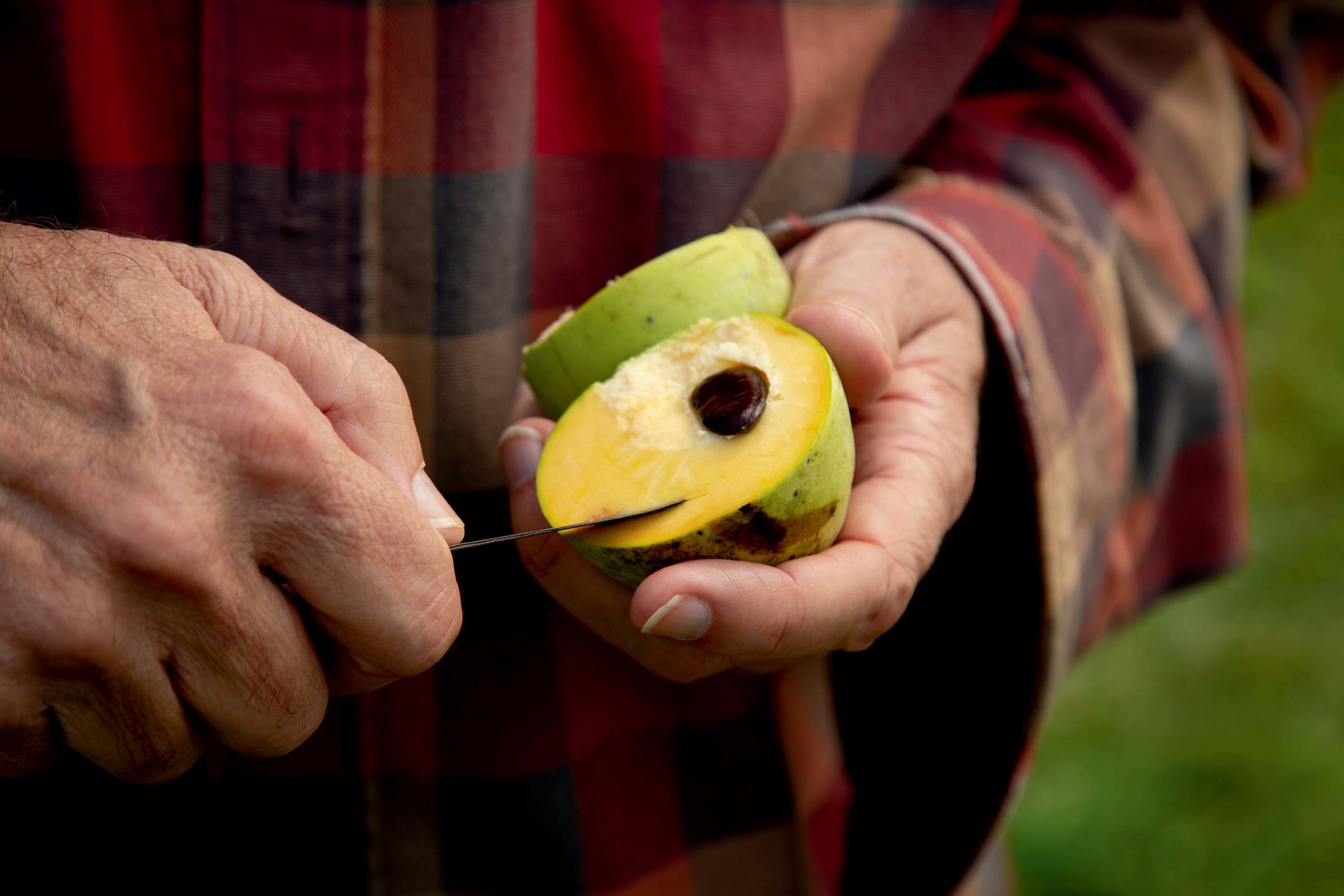
Photo: helen norman
Slicing into the fruit’s golden flesh.
Twenty-five years ago, I was walking the woods along the Potomac not two miles from the White House with my foraging mentor, a cranky, gravel-voiced woman named Paula Smith. “It’s a weird tree, okay?” she called over her shoulder as we walked into the gloom of the woods. “The flowers are sorta liver colored and don’t smell too good. That’s ’cause they get pollinated by scavenger insects, blowflies and beetles. You really want to help them out, you hang some roadkill in the tree.”
I was suddenly less interested in finding and eating the largest edible fruit in North America, but I didn’t want to tell her that. We soon found a cluster of the spindly brown trees, but none that had fruit. “A lot of ’em don’t produce,” she said. “They need the right amount of water at the right time.” The next cluster—each stand of trees is often a single organism, she explained—had bunches of green fruit the size of baked potatoes. Smith told me to shake the tree. “But gently,” she barked. “Not like the friggin’ yuppies who come out here and break the trees.” I shook and two pawpaws thudded down, one glancing off the side of my head. I looked at her accusingly. “Oh yeah, that happens,” she said nonchalantly. “Wear a hat. And look up when you shake.”
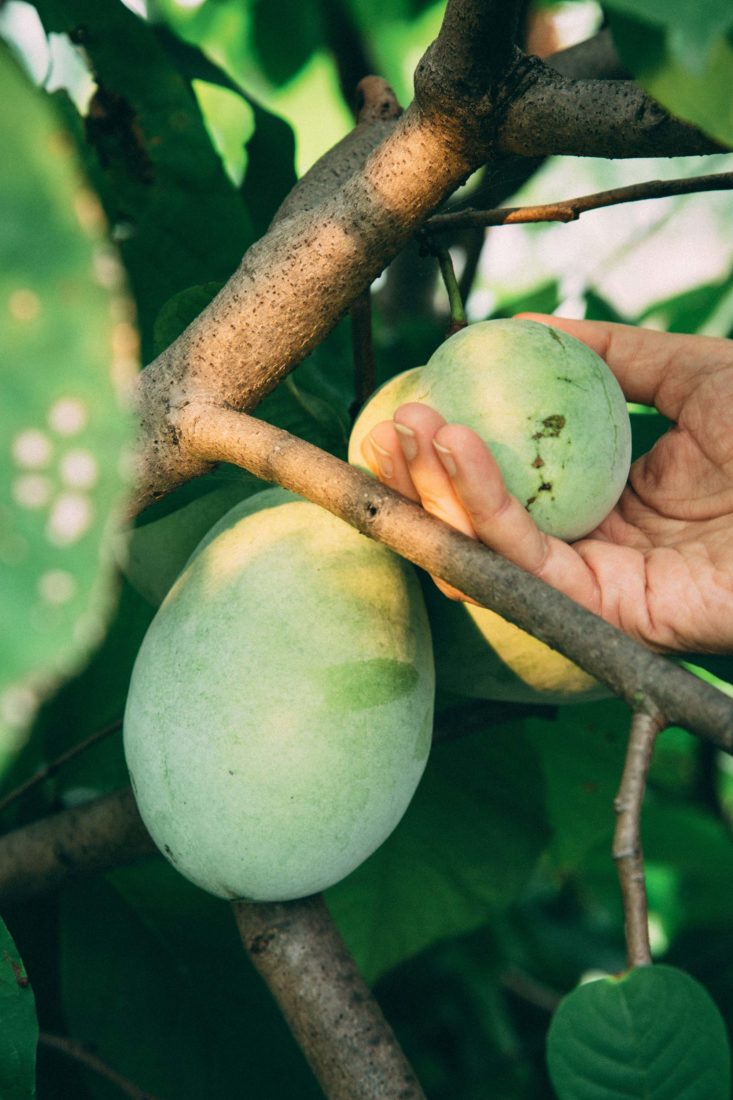
Photo: helen norman
Checking a Shenandoah pawpaw for ripeness.
The ripe pawpaw was firm but yielding, like an avocado. I cut it open, sucked the flesh from the peel, and spat out the big, flat seeds. The flesh was yellow orange with a luscious texture, almost like a custard. But it was the taste—luxurious, sweet, with a long finish—that threw me. It tasted tropical, the fruit of a tree rooted in Costa Rica with three-thousand-mile-long branches. The flavor was not unlike a banana. It also had hints of mango and papaya, even pineapple. But none of the “tastes like” descriptors do it justice. A pawpaw tastes like a pawpaw. There’s nothing else like it.
Pawpaws are having something of a moment these days. Throughout the fruit’s native range—it grows wild in twenty-six states, including most of the South and as far north as Michigan—craft brewers are making pawpaw beer and ale. You can find pawpaw ice cream in high-end restaurants. Facebook groups like Pawpaw Fanatics count several thousand followers posting trophy photos of their finds. Lori Mackintosh, who runs a you-pick fruit and vegetable farm in Berryville, Virginia, that supplies pawpaws, says she can spot people who want them as soon as they get out of their cars. When I ask how, she says, “Well, dreadlocks and BO,” then laughs at her own description.
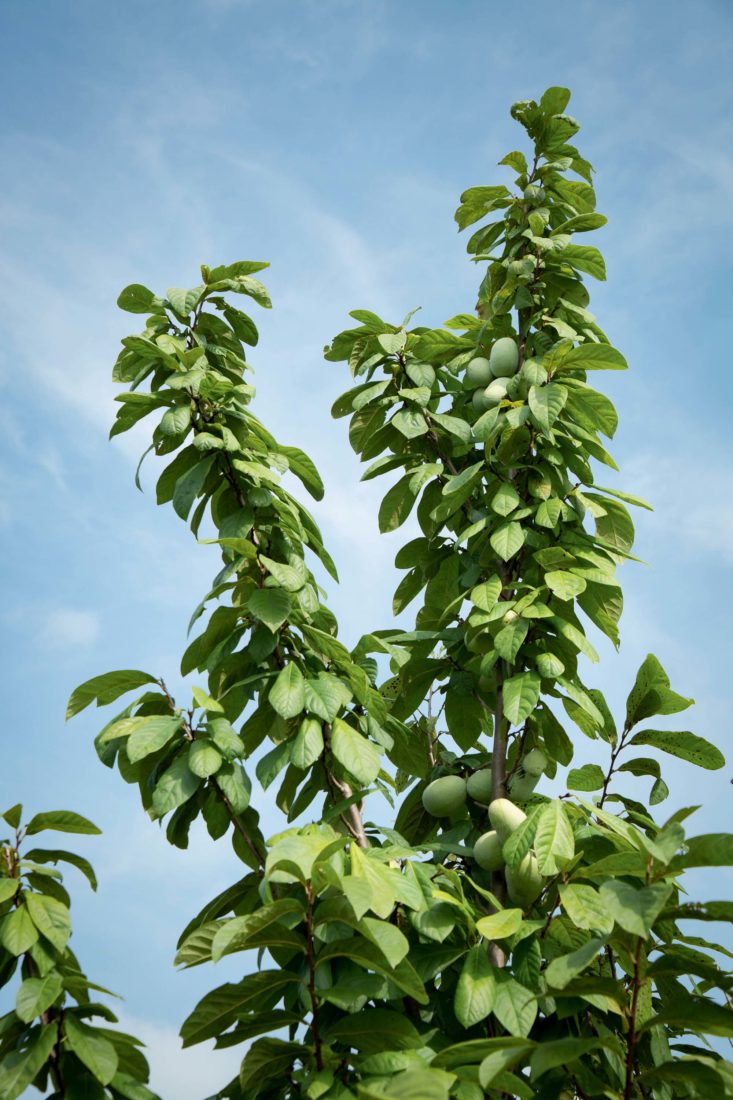
Photo: helen norman
The green fruit hidden among the branches.
But to understand the moment, you need to know that pawpaws were much better known in centuries past than they are today. The Indians had been happily eating them for millennia before European settlers arrived. According to some reports, George Washington’s favorite dessert was chilled pawpaws. Thomas Jefferson planted pawpaw trees at Monticello and sent seeds to friends in Europe. Pawpaws sustained Lewis and Clark when their rations ran low on their journey to the unexplored West. They were commonly consumed back when we were a rural people. West Virginia, Michigan, and Illinois all have towns or villages named after the pawpaw. It’s the state fruit of Ohio.
The late nineteenth and early twentieth centuries saw flurries of interest, including an exhaustive 1905 treatise with the fetching title The Pawpaw: A Native Fruit of Great Excellence. But the big event in the pawpaw timeline came in 1916, when the American Genetic Association offered fifty-dollar cash prizes for the largest individual tree and for the tree bearing the best fruit. The contest attracted fruit from seventy-five trees across the country. The best-fruit winner belonged to a Mrs. Frank Ketter, of Ironton, Ohio. “The flesh is medium yellow in color, mild but very rich in flavor, neither insipid nor cloying,” the judges wrote. “The amount and quality of the flesh, together with the good shipping and ripening qualities of the fruit, make this an extremely desirable variety.”
So what happened? Andrew Moore in his book Pawpaw: In Search of America’s Forgotten Fruit succinctly sums it up: “On the heels of this contest came no radical change in the pawpaw’s standing. Nothing much happened at all.”

Photo: helen norman
Fresh pawpaw seeds.
But it was also as if the fruit were intentionally difficult, even defiant. Pawpaws bruise easily. Compared with other fruits, they don’t ship well. They have a capriciously short ripeness season—usually a few weeks in September, possibly a few days in late August or early October. Pick one before it’s ripe and it goes from solid to mush (although you can keep an almost-ripe one in the fridge for three weeks). The pulp does freeze well, and pawpaw ice cream and milkshakes are amazing, but serious aficionados caution you not to cook with them. Under heat, pawpaws lose their vivid zing and taste ordinary, sort of like bananas. In which case you might as well use bananas in the first place.
If pawpaws ever do become widely known and accepted, it will be thanks to a mild but obsessed man named Neal Peterson, who has been called the Johnny Appleseed of pawpaws, or Papa Pawpaw. Peterson, a Quaker with a sly sense of humor and an admiration for Gandhi, prefers the Mahatma of Pawpaws. The single bumper sticker on the back of his Prius reads, HOW DOES YOUR LIFE REMOVE THE CAUSES OF WAR?
When I pull up to his house in Harpers Ferry, West Virginia, population about 280, I notice two lawn deer arranged in the grass out front. They come to life and bound away as I approach. As I look around the modest house with a long front porch where Peterson keeps tools, pots of flowers, and a plastic tray of pawpaw seedlings, the seventy-two-year-old tells me he rented it furnished. Not even the rugs or artwork are his. But the photos, I say, gesturing to the framed images of family. “They came with the place, too,” he says. “I guess I didn’t see any reason to take them down.” He sounds either mildly apologetic or mildly disturbed at the notion that what’s on his walls makes any difference. This, I decide, is a man who treads lightly upon the earth, who lives in his head. And what his head is full of is pawpaws.
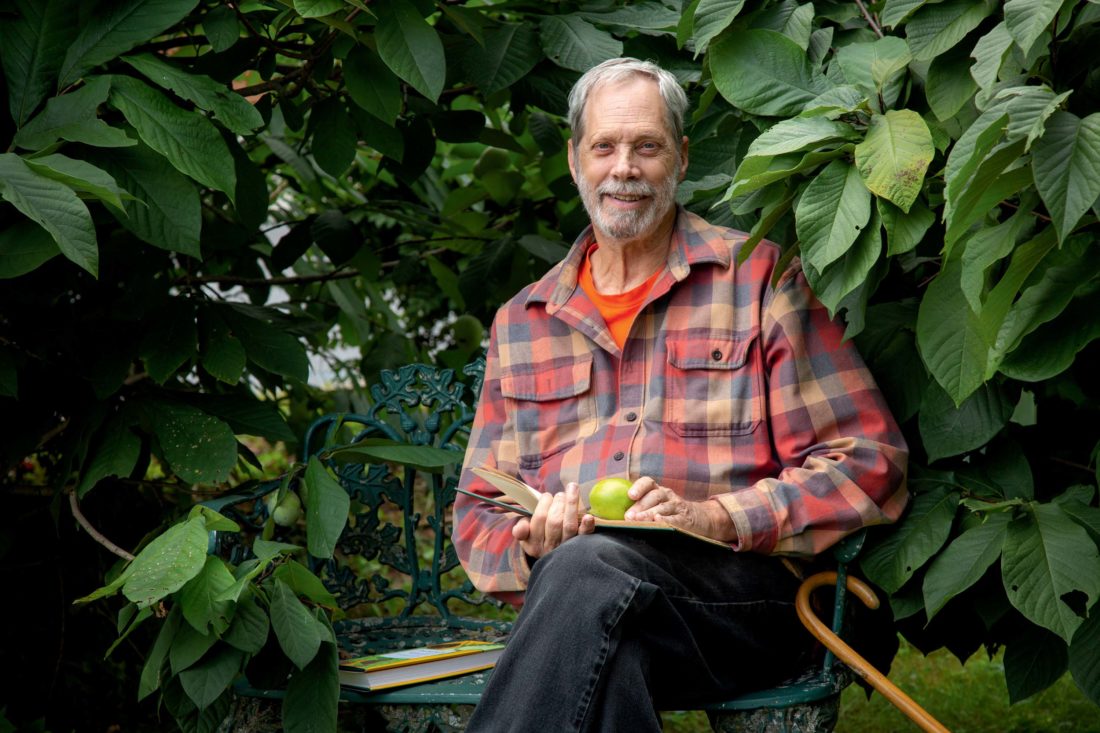
Photo: helen norman
Pawpaw breeder Neal Peterson in Harpers Ferry.
An unassuming zealot and a pioneer, Peterson has quietly trademarked seven varieties of pawpaws and dedicated his life to popularizing the forgotten fruit. He just happens to have a couple of his varieties on hand for me to try. One is Shenandoah. It has a custardy texture and a sweet and mellow taste. Wild pawpaws sometimes have a bitter note at the end of the long finish. Not this one. The other is Susquehanna, his personal favorite. It’s a big pawpaw, sweeter and richer, with a buttery texture. Both are exceptional, at least as good as the best wild fruit I’ve ever had. Over the years, Peterson has tasted so many pawpaws that his throat gets irritated when he eats one of inferior quality. In between samples, he cleanses his palate with water and a cracker, just like a wine taster.

Photo: helen norman
The grafting process.
Nearly all of the places Peterson has lived in his life have been rentals. The exception was a fifty-three-acre farm he cashed out his retirement savings and everything else to buy in 2000 in Pendleton County, West Virginia. In May of that year, he hired high school students to help him plant 3,000 grafted pawpaw trees. The night of May 5 it rained, which he took as a harbinger of a good harvest. It didn’t rain again until mid-August, the worst drought since 1930. He lost 2,950 trees, and the 50 that survived were too stressed to make it through the winter. “It was pawpaws or bust,” he tells me over lunch at the Mountain View Diner in Charles Town. “And I went bust.” He seems detached from the disaster, as if it were just a temporary setback. Which, in the long trajectory of his life as a plant breeder, it was.
Peterson grew up in Saint Albans, West Virginia, the middle child of three. The son of a schoolteacher and her research chemist husband, he was aware of pawpaws growing up but never thought the fruit was good for much besides throwing at other kids. But he loved the woods. It was a place to get away, a place he felt like himself.
The moment that set the course of his life came in 1975, when he was a graduate student and teaching assistant studying plant genetics at West Virginia University. On a hike with students one day, he smelled ripe pawpaw fruit in the university’s arboretum. “At the time, I didn’t think it was professional for me to be eating a wild fruit off the ground in front of students,” he says. But later he returned and tried one. “The light bulb turned on. It was an epiphany, a revelation. I couldn’t believe that there was a wild fruit that tasted this good.”
He knew from his studies that nearly all the cultivated fruits we eat have benefited from thousands of years of selective breeding. Apples and peaches are thought to have been domesticated more than 4,000 years ago. Oranges are a roughly 3,000-year-old hybrid of the mandarin and the pomelo. What, he wondered, might the pawpaw be now had it been subjected to similar selective breeding? If pawpaws had existed in Mesopotamia a few thousand years ago, he says, they’d be in American supermarkets today. “Look, I wasn’t a plant breeder or grower by any means,” he tells me. “But I said to myself, ‘I’m capable of doing this. Nobody else is doing this. And it’s crying out to be done.’” And so he took on the task of domesticating the wild pawpaw.
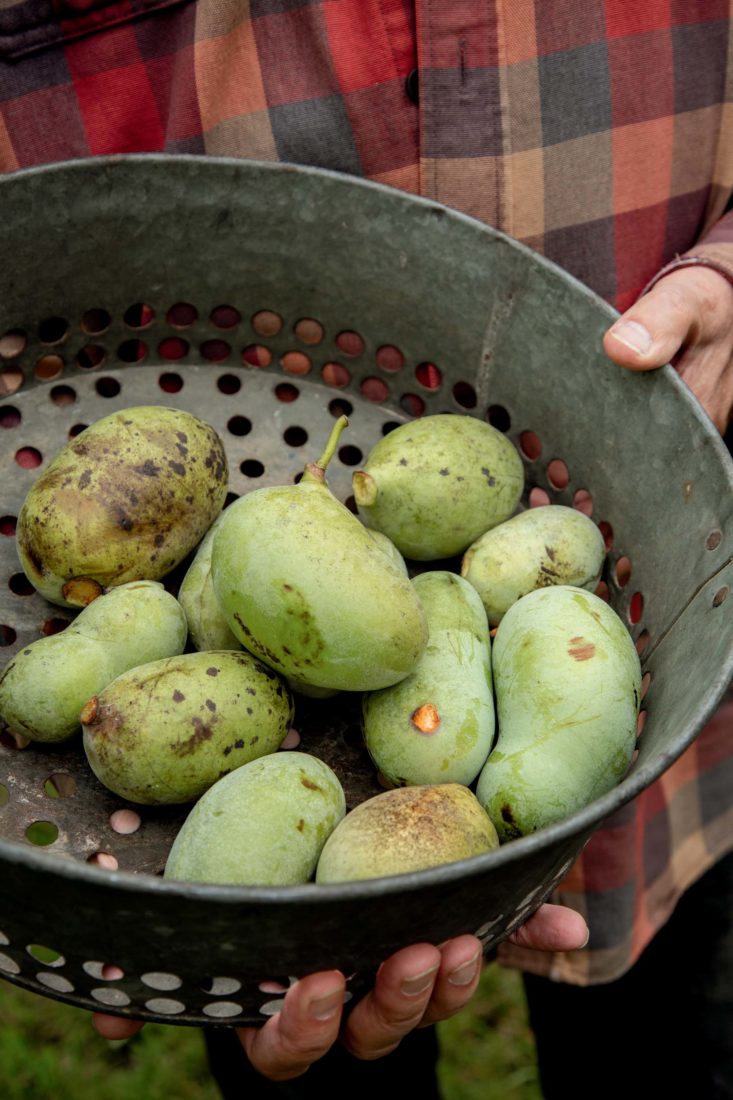
Photo: helen norman
An array of pawpaws in various shapes.
One of the big problems was time. A pawpaw tree requires seven or eight years before it produces fruit, and you need fruit from three different years to do a proper evaluation. Trees are complicated, he tells me. They vary from year to year, as does the fruit. Even fruit from different branches of the same tree may taste different. It takes a decade to see scientific results. And that’s just one generation. No industrial producer wants to spend that kind of time and money on an unproven fruit. That takes a visionary. Or a fanatic.
Reasoning that the lost cultivars from the 1916 contest contained the best genetic material, he set out to find them. He waded through old records in courthouses and churches. He logged countless miles on back roads, trying to locate farms where the owners had grown and experimented with pawpaws. Many old farms had been turned into corn and soybean fields. Some were housing developments.
In 1980, five years after the light bulb went on, Peterson visited the Blandy Experimental Farm in Boyce, Virginia. He had reason to believe that a collection of seeds including descendants of the prize-winning Ketter fruit had once been grown there. The staff at Blandy seemed to have no interest in pawpaws, but someone remembered that there had once been some trees in what was now the backwoods. He was welcome to walk there if he wanted. The tall oaks and hickories were anything but good pawpaw habitat, but a fair way in, Peterson took a step and spotted a cluster of pawpaw trees. A few more steps and the cluster resolved itself into a straight line, evidence of cultivation. Several yards farther, he found another row. That September, he came back to sample the fruit. It was exceptional—large, round, and sweet, with a high ratio of flesh to seeds. It was just what he’d been looking for.
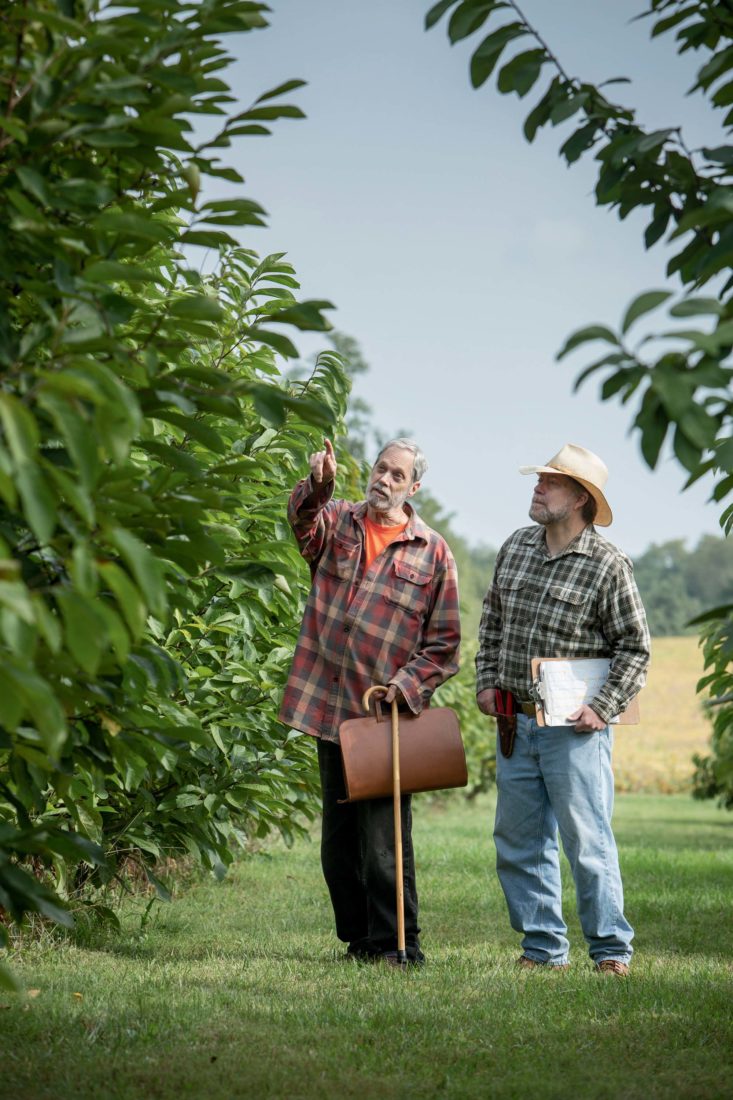
Photo: helen norman
Peterson and research assistant Rodney Dever evaluate fruit.
Peterson took a job with the USDA in D.C. as an agricultural economist and plotted his next move. “For a breeding project, ten thousand trees would have been ideal,” he says. “But for that you need a staff, and I didn’t have one.” Instead he had friends, as well as a knack for “Tom Sawyering” them (his term) into helping out. “For a lot of my friends living in the city, you know, it was kind of an adventure to be planting an orchard.” He had the same knack for persuading people with land to let him use some of it for his project. By 1982, he had planted nine hundred seedlings—from the Blandy collection along with an eclectic gathering of seeds he’d found over the course of his travels—at the University of Maryland Wye Research and Education Center. A few years later, he planted another six hundred at the university’s Western Maryland research center in Keedysville. And for the next dozen years, he devoted his weekends and vacations to his trees.
By 1996, Peterson had ruthlessly selected the eighteen best varieties from his fifteen hundred trees, and despite losing three thousand trees at his short-lived Pendleton County farm, he kept at it. By 2004, he was in the process of trademarking six varieties and was marketing them through his business, Peterson Pawpaws. His most recent variety is a pawpaw he calls Tallahatchie. Many people name their fruit varieties after themselves, but that wasn’t how he rolled. “I was taught that your life ought to contribute something to others,” he says. “Pawpaws are important. I’m not.” He settled on rivers, along which the fruit naturally grows. And he selected rivers with Indian names, since Native Americans were the original pawpaw enthusiasts—Potomac, Shenandoah, Susquehanna, Rappahannock, Wabash, Allegheny.
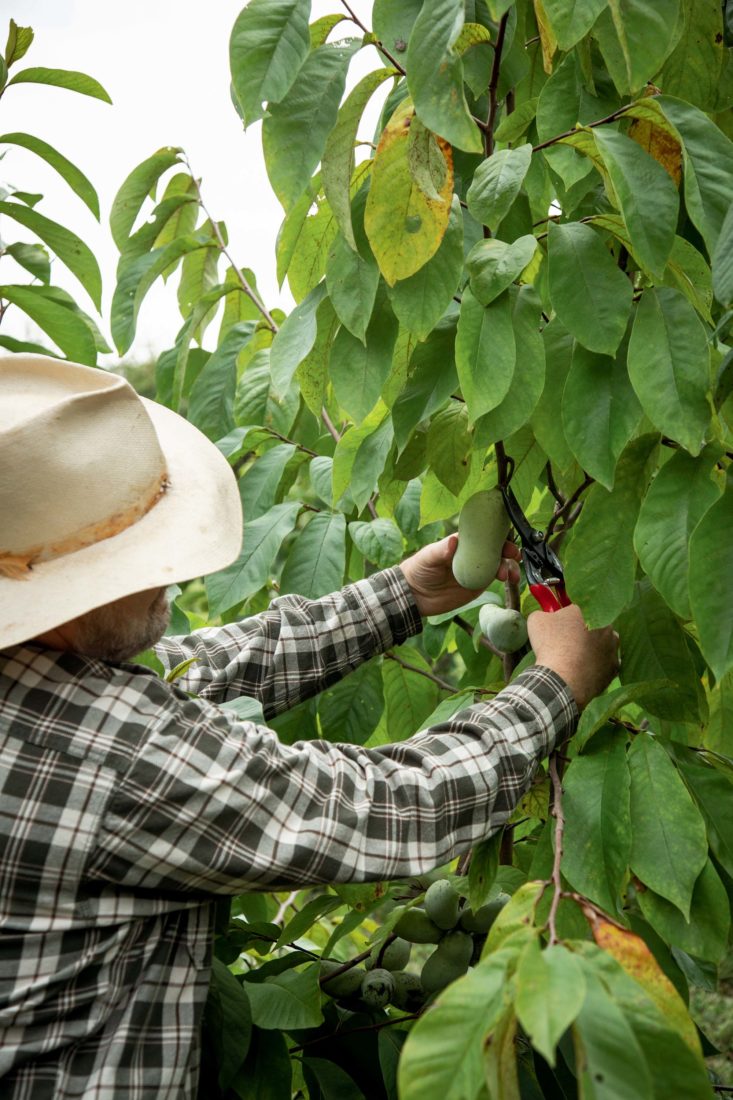
Photo: helen norman
Dever harvests a pawpaw.
For a couple of years, Peterson sold fruit and trees directly, but he quickly found himself with a two-year waiting list. “I realized that this was no way to run a business,” he says. Instead, he now licenses his trees to nurseries—fifteen of them in North America, and nine overseas, including in Germany, France, the Netherlands, and Japan. “A plant breeder’s work is never done,” he says with a smile. His latest project is breeding pawpaw as an ornamental. “It’s a beautiful tree—those big glossy leaves—and very hardy.”
While pawpaws won’t be available in supermarkets during his lifetime, they are starting to appear more widely in farmers’ markets, and as a fruit breeder, Peterson takes the long view. It may be centuries before pawpaws are as well known as, say, blueberries. In that sense, we’re still in the fruit’s infancy. But he has helped birth the baby. He has done what he set out to do.
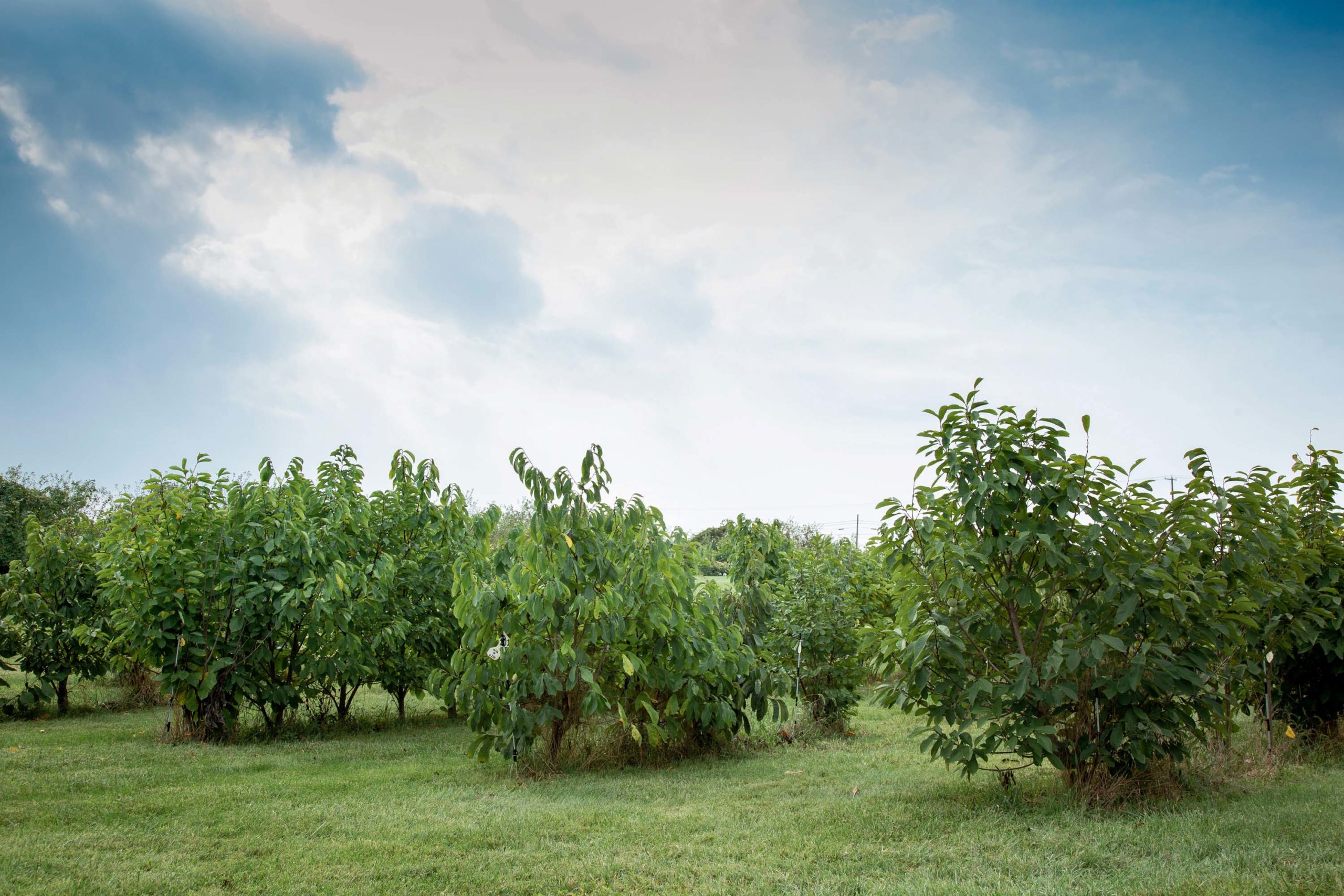
Photo: helen norman
A breeding orchard of pawpaw trees.
After tasting Peterson’s varieties, I was half afraid that they had spoiled me for wild fruit, which is less consistent and seedier. But then Paula Smith called last September. She’s not the type for small talk. “They’re ready,” she said. “Pick me up at seven tomorrow morning.” I’d found a few good trees myself by then, but I knew she’d have more and better trees than I did.
The next morning we were back in the woods along the Potomac, shaking trees and dodging pawpaws as they thudded down. The first ones I tried weren’t great. Two weren’t ripe. Two were okay but had a slightly bitter aftertaste. I resolved to try a few more. I picked the next one up, sliced it open, sucked the flesh from the peel, and spat the seeds. “How is it?” Smith asked.
It was September on my tongue, sweet and luscious to the very end.
“It’s amazing.”


